Selected Properties of Single and Multi-Layered Particleboards with the Structure Modified by Fibers Implication
Abstract
1. Introduction
2. Materials and Methods
2.1. Materials
2.2. Elaboration of Panels
- -
- Constant factors: number of layers 1, nominal density 660 kg m−3, fibers type 1; variable factor: mass share of fibers 0%, 25%, 50%, and 75% (panel type: 1–4, respectively, to rising fibers share);
- -
- Constant factors: number of layers 3, nominal density 660 kg m−3, fibers type 1, face layers mass share 16%; variable factor: mass share of fibers in face layers 0%, 25%, 50%, and 75% (panel type: 5–8, respectively, to rising fibers share);
- -
- Constant factors: number of layers 3, nominal density 660 kg m−3, fibers type 1, face layers mass share 32%; variable factor: mass share of fibers in face layers 0%, 25%, 50%, and 75% (panel type: 9–12, respectively, to rising fibers share);
- -
- Constant factors: number of layers 3, fibers type 1, face layers mass share 32%, the mass share of fibers in face layers 50%; variable factor: nominal density 580, 620, 660, and 710 kg m−3 (panel type: 13, 14, 11, and 15, respectively, to rising density);
- -
- Constant factors: number of layers 5 (large particles in the core, fine particles in the middle layer, fibers on face layers, nominal density 660 kg m−3, face layers mass share 32%, the mass share of fibers in face layers 25%; variable factor: fibers type 1 and 2 (panel type: 16 and 17, respectively, to fibers type);
- -
- Constant factors: number of layers 3, fibers type 2, face layers mass share 32%, the mass share of fibers in face layers 50%; variable factor: nominal density 580, 620, 660, and 710 kg m−3 (panel type: 18, 19, 20, and 21, respectively, to rising density).
2.3. Panels’ Examination
2.4. Statistical Analysis
3. Results and Discussion
3.1. Modulus of Rupture and Modulus of Elasticity
3.2. Internal Bond and Density
3.3. Surface Soundness
3.4. Surface Roughness
3.5. Density Profiles
4. Conclusions
Author Contributions
Funding
Institutional Review Board Statement
Informed Consent Statement
Data Availability Statement
Acknowledgments
Conflicts of Interest
References
- Pałubicki, B.; Hlásková, L.; Frömel-Frybort, S.; Rogoziński, T. Feed force and sawdust geometry in particleboard sawing. Materials 2021, 14, 945. [Google Scholar] [CrossRef] [PubMed]
- Borowski, W.; Dudziec, K.; Odachowski, L.; Osika, S.; Płoszek, A.; Rodzeń, K.; Wierzbicki, A.; Żukowski, L. Technologia Płyt Pilśniowych; Wydawnictwo Przemysłu Lekkiego i Spożywczego: Warszawa, Poland, 1965. [Google Scholar]
- Mirski, R.; Dziurka, D.; Banaszak, A. Effects of Manufacture Conditions on Physical and Mechanical Properties of Rape-Polymer Boards. Wood Res. 2019, 64, 659–666. [Google Scholar]
- Tabarsa, T.; Ashori, A.; Gholamzadeh, M. Evaluation of surface roughness and mechanical properties of particleboard panels made from bagasse. Compos. Part B Eng. 2011, 42, 1330–1335. [Google Scholar] [CrossRef]
- Sam-Brew, S.; Smith, G.D. Flax and Hemp fiber-reinforced particleboard. Ind. Crops Prod. 2015, 77, 940–948. [Google Scholar] [CrossRef]
- Fiorelli, J.; Bueno, S.B.; Cabral, M.R. Assessment of multilayer particleboards produced with green coconut and sugarcane bagasse fibers. Constr. Build. Mater. 2019, 205, 1–9. [Google Scholar] [CrossRef]
- Zhang, L.; Hu, Y. Novel lignocellulosic hybrid particleboard composites made from rice straws and coir fibers. Mater. Des. 2014, 55, 19–26. [Google Scholar] [CrossRef]
- Ozdemir, T.; Hiziroglu, S.; Malkocoglu, A. Influence of relative humidity on surface quality and adhesion strength of coated medium density fiberboard (MDF) panels. Mater. Des. 2009, 30, 2543–2546. [Google Scholar] [CrossRef]
- Ulker, O. Surface roughness of composite panels as a quality control tool. Materials 2018, 11, 407. [Google Scholar] [CrossRef]
- Hiziroglu, S.; Kosonkorn, P. Evaluation of surface roughness of Thai medium density fiberboard (MDF). Build. Environ. 2006, 41, 527–533. [Google Scholar] [CrossRef]
- Ustaomer, D.; Usta, M.; Hiziroglu, S. Effect of boron treatment on surface characteristics of medium density fiberboard (MDF). J. Mater. Process. Technol. 2008, 199, 440–444. [Google Scholar] [CrossRef]
- Hafezi, S.M.; Doosthoseini, K. The influence of silane coupling agent and poplar particles on the wettability, surface roughness, and hardness of UF-bonded wheat straw (Triticum aestivum L.)/poplar wood particleboard. J. For. Res. 2014, 25, 667–670. [Google Scholar] [CrossRef]
- de Cademartori, P.H.G.; Schreiner, W.H.; Magalhães, W.L.E. Facile one-step fabrication of highly hydrophobic medium density fiberboard (MDF) surfaces via spray coating. Prog. Org. Coatings 2018, 125, 153–159. [Google Scholar] [CrossRef]
- Hartono, R.; Dalimunthe, A.M.; Iswanto, A.H.; Herawati, E.; Sutiawan, J.; de Azevedo, A.R.G. Mechanical and Physical Properties of Particleboard Made from the Sumatran Elephant (Elephas maximus sumatranus) Dung and Wood Shaving. Polymers 2022, 14, 2237. [Google Scholar] [CrossRef] [PubMed]
- Tupciauskas, R.; Rizhikovs, J.; Andzs, M.; Bikovens, O. Influence of Manufacturing Conditions on Binder-Less Boards from Steam-Exploded Hemp Shives and Wheat Straw. Materials 2022, 15, 3141. [Google Scholar] [CrossRef]
- Król, P.M.; Podziewski, P.; Hanincová, L. Deviation of coordinates of small-dimension holes in fiberboard. Wood Mater. Sci. Eng. 2022, 1–6. [Google Scholar] [CrossRef]
- Eroğlu, H.; İstek, A.; Usta, M. Medium density fiberboard (MDF) manufacturing from wheat straw (Triticum aestivum L.) and straw wood mixture. J. Eng. Sci. 2001, 7, 305–311. [Google Scholar]
- Zyryanov, M.; Medvedev, S.; Mokhirev, A. Study of the possibility of using logging residue for the production of wood processing enterprises. J. Appl. Eng. Sci. 2020, 18, 15–18. [Google Scholar] [CrossRef]
- Vititnev, A.; Christova, N.; Alashkevich, Y.; Matygulina, V.; Marchenko, R. Optimization of wood fibre refining process in fibreboard production with new refiner disc working surface geometry. Bioresources 2021, 16, 7751–7766. [Google Scholar] [CrossRef]
- Mishurov, N.P.; Voytyuk, M.M.; Vinogradov, P.N.; Machneva, O.P.; Voytyuk, V.A. Application of waste products of crop processing in the production of building materials for agricultural facilities. IOP Conf. Ser. Earth Environ. Sci. 2021, 723, 032053. [Google Scholar] [CrossRef]
- Osterholm, H. Freeness and fibre morphology measurement for quality control. Pulp Pap. Logist. 2021, 10–13. Available online: https://library.e.abb.com/public/bf3facf128a54b1385e1ea6c869f88ee/Freeness%20and%20fibre%20morphology%20measurement%20for%20quality%20control_PulpPaperLogistics_JulyAug2021.pdf (accessed on 20 September 2022).
- EN 326-2:2010+A1; Wood-Based Panels. Sampling, Cutting and Inspection. Initial Type Testing and Factory Production Control. European Committee for Standardization: Brussels, Belgium, 2014.
- EN 326-1; Wood-Based Panels. Sampling, Cutting and Inspection. Sampling and Cutting of Test Pieces and Expression of Test Results. European Committee for Standardization: Brussels, Belgium, 1993.
- EN 310; Wood-Based Panels. Determination of Modulus of Elasticity in Bending and of Bending Strength. European Committee for Standardization: Brussels, Belgium, 1993.
- EN 319; Particleboards and Fibreboards—Determination of Tensile Strength Perpendicular to the Plane of the Board. European Committee for Standardization: Brussels, Belgium, 1993.
- EN 311; Wood-Based Panels—Surface Soundness—Test Method. European Committee for Standardization: Brussels, Belgium, 2003.
- EN 312; Particleboards—Specifications. European Committee for Standardization: Brussels, Belgium, 2010.
- Savov, V. Influence of Pulp Freeness on Hardwood Fiberboards Properties. Ann. Fac. Eng. Hunedoara J. Eng. 2008, VI, 65–72. [Google Scholar]
- Hong, M.K.; Lubis, M.A.R.; Park, B.D. Effect of panel density and resin content on properties of medium density fiberboard. J. Korean Wood Sci. Technol. 2017, 45, 444–455. [Google Scholar] [CrossRef]
- Jafarnezhad, S.; Shalbafan, A.; Luedtke, J. Effect of surface layers compressibility and face-to-core-layer ratio on the properties of lightweight hybrid panels. Int. Wood Prod. J. 2018, 9, 164–170. [Google Scholar] [CrossRef]
- Sala, C.M.; Robles, E.; Kowaluk, G. Influence of the Addition of Spruce Fibers to Industrial-Type High-Density Fiberboards Produced with Recycled Fibers. Waste Biomass Valorization 2021, 12, 4033–4042. [Google Scholar] [CrossRef]
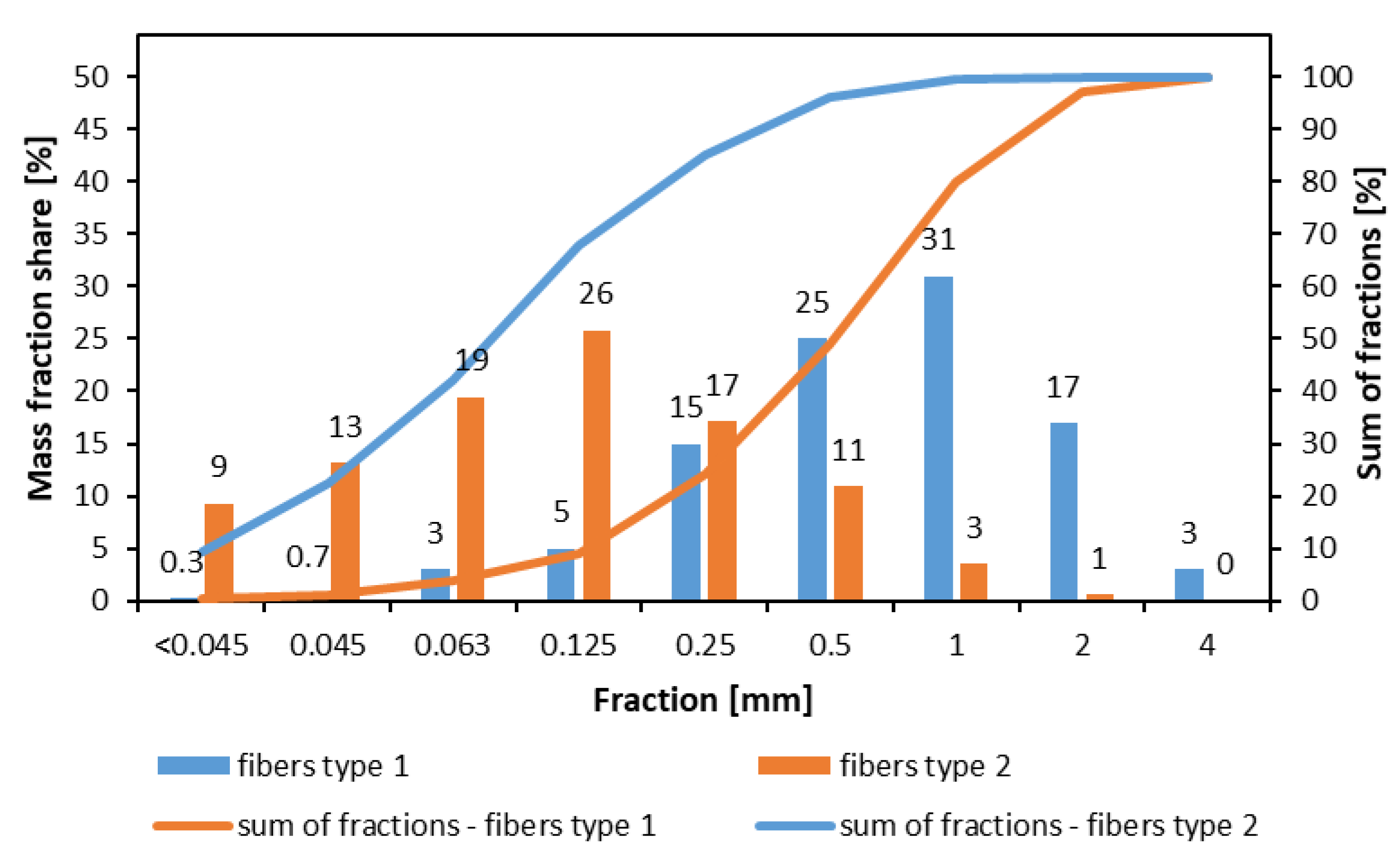
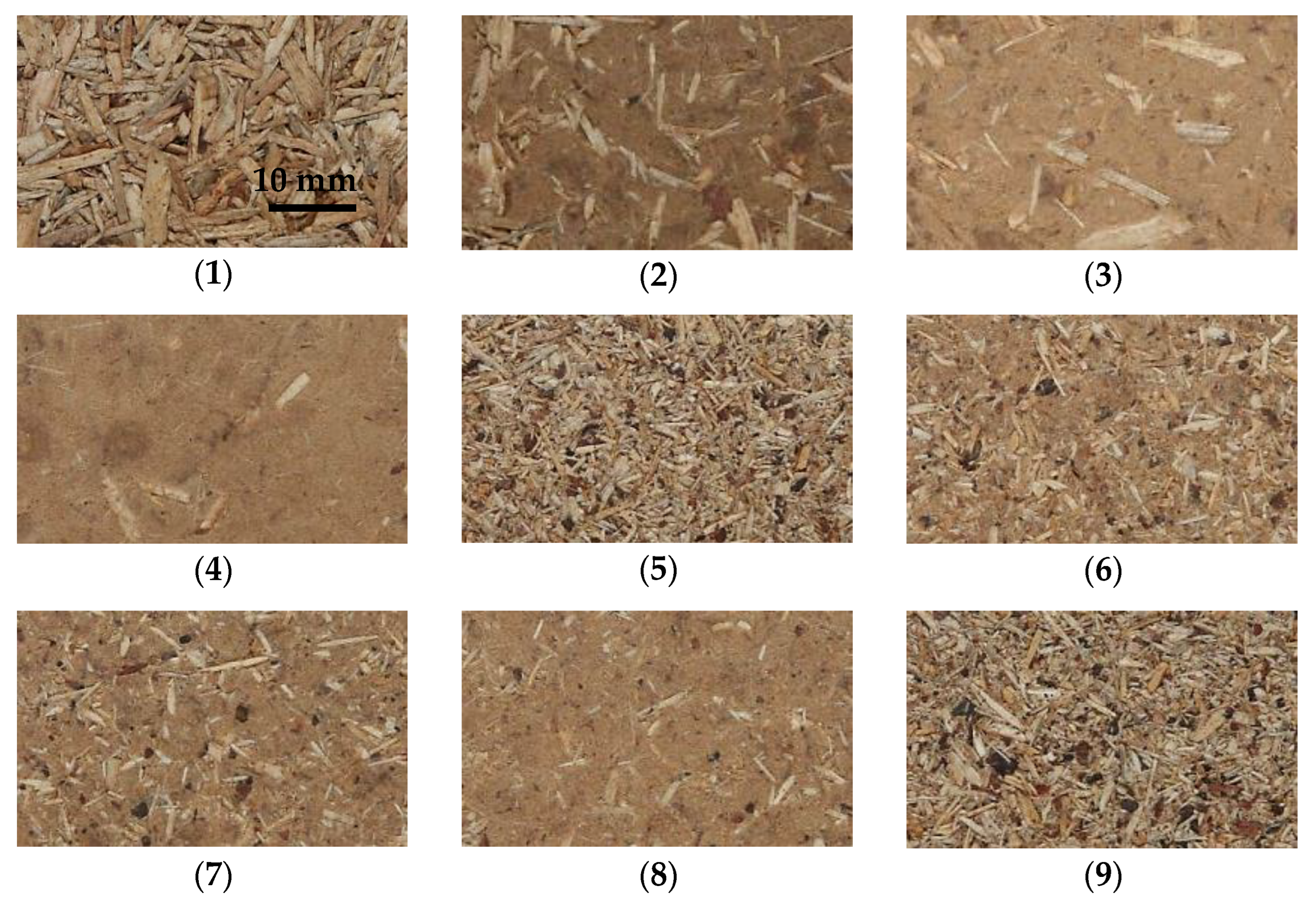


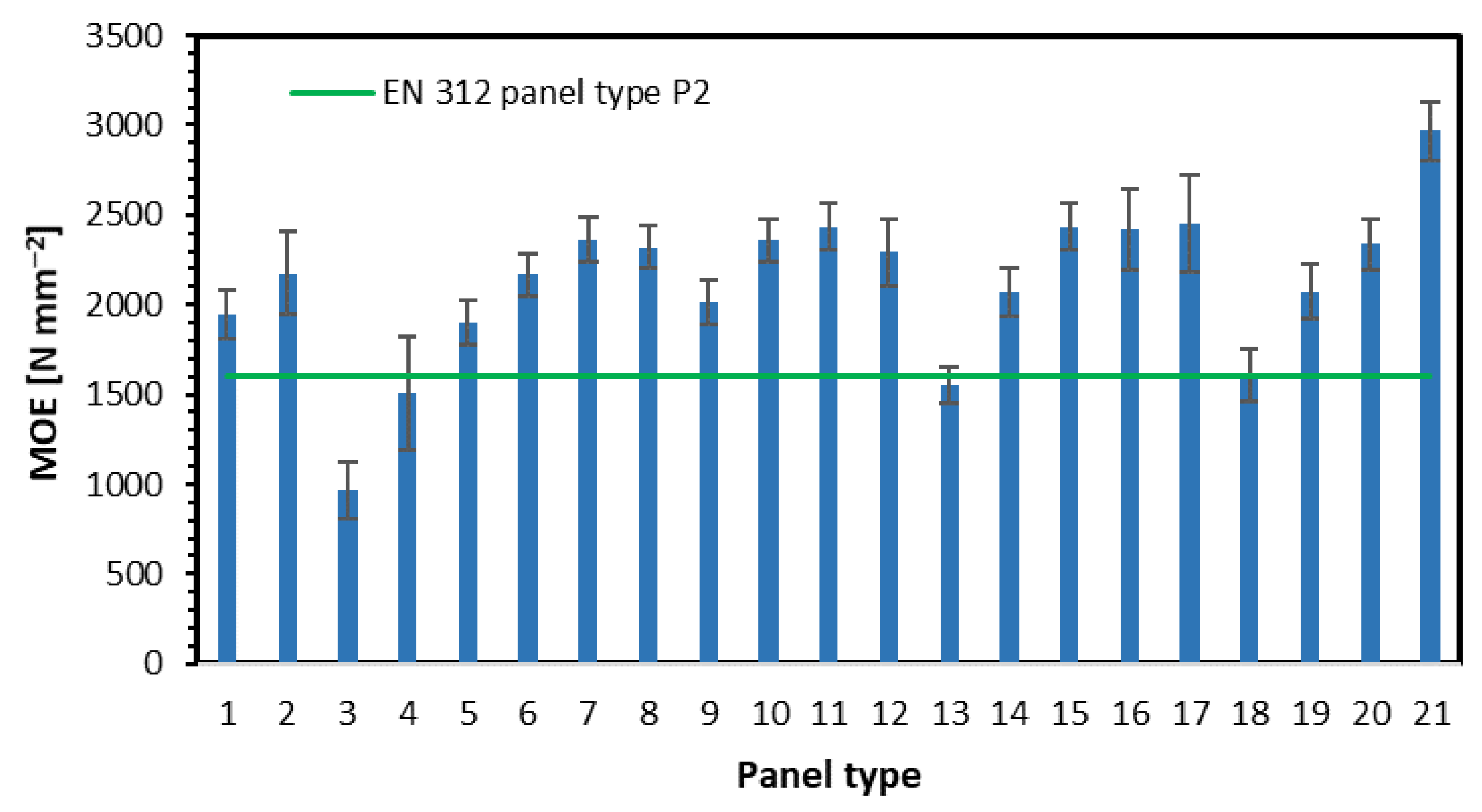

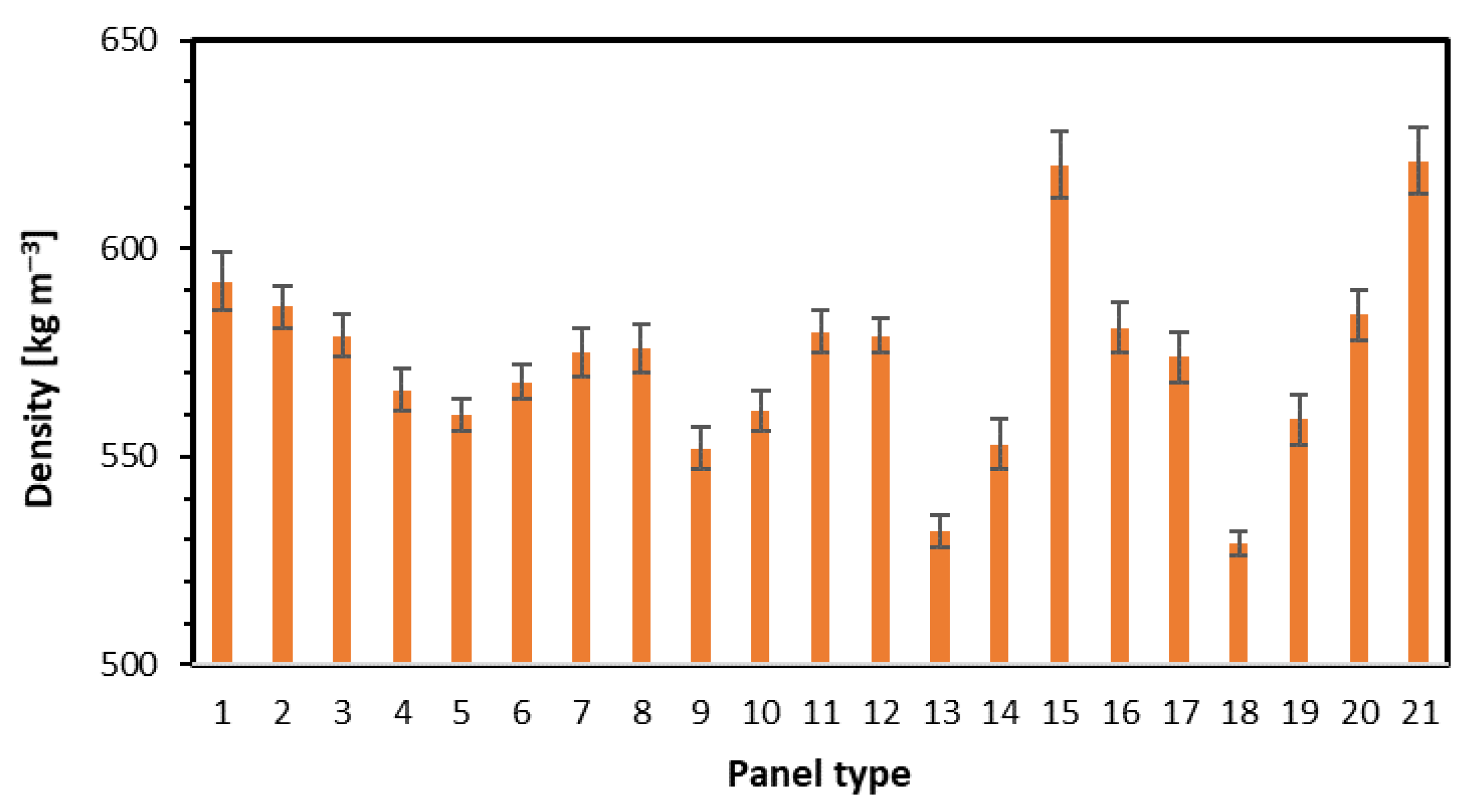
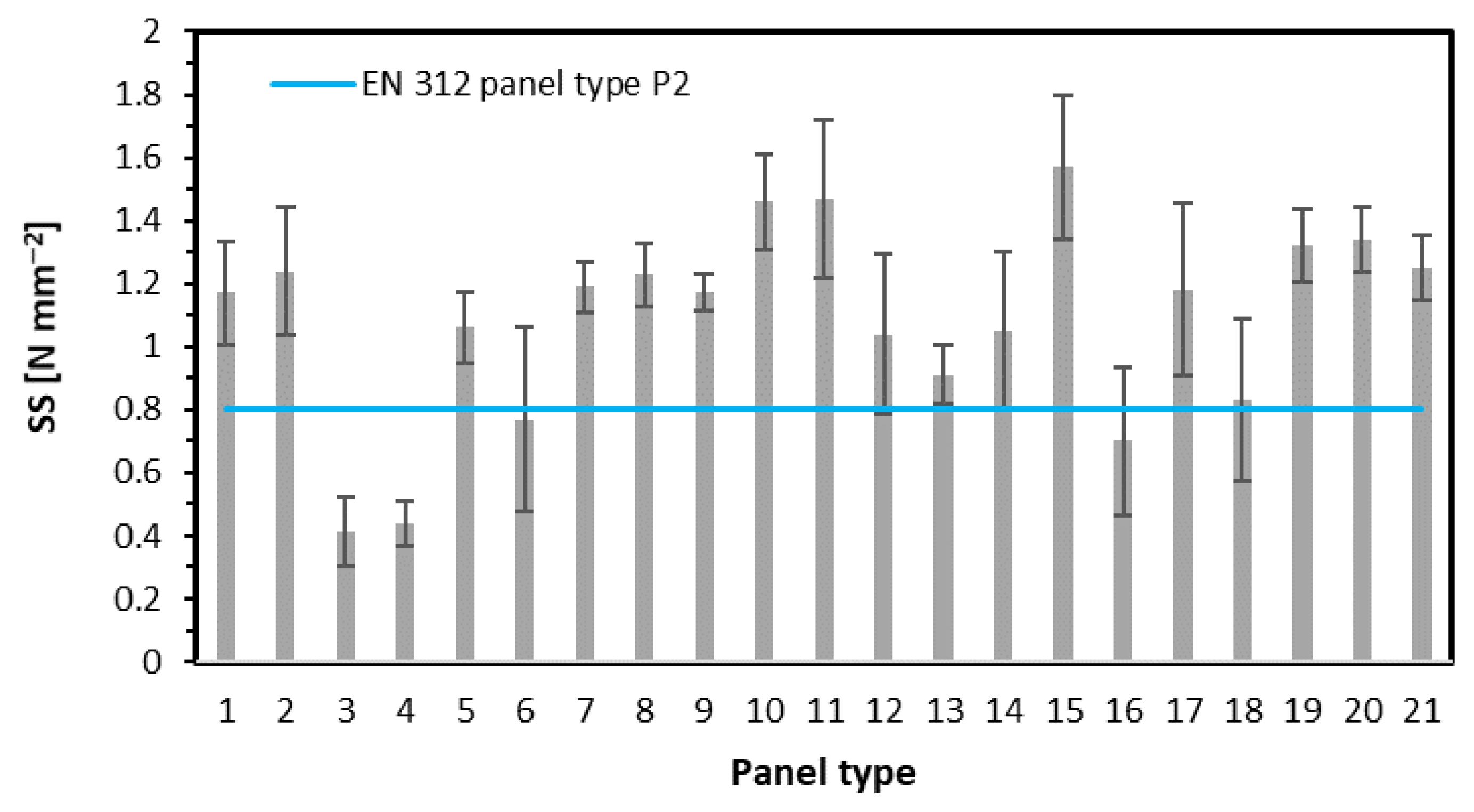

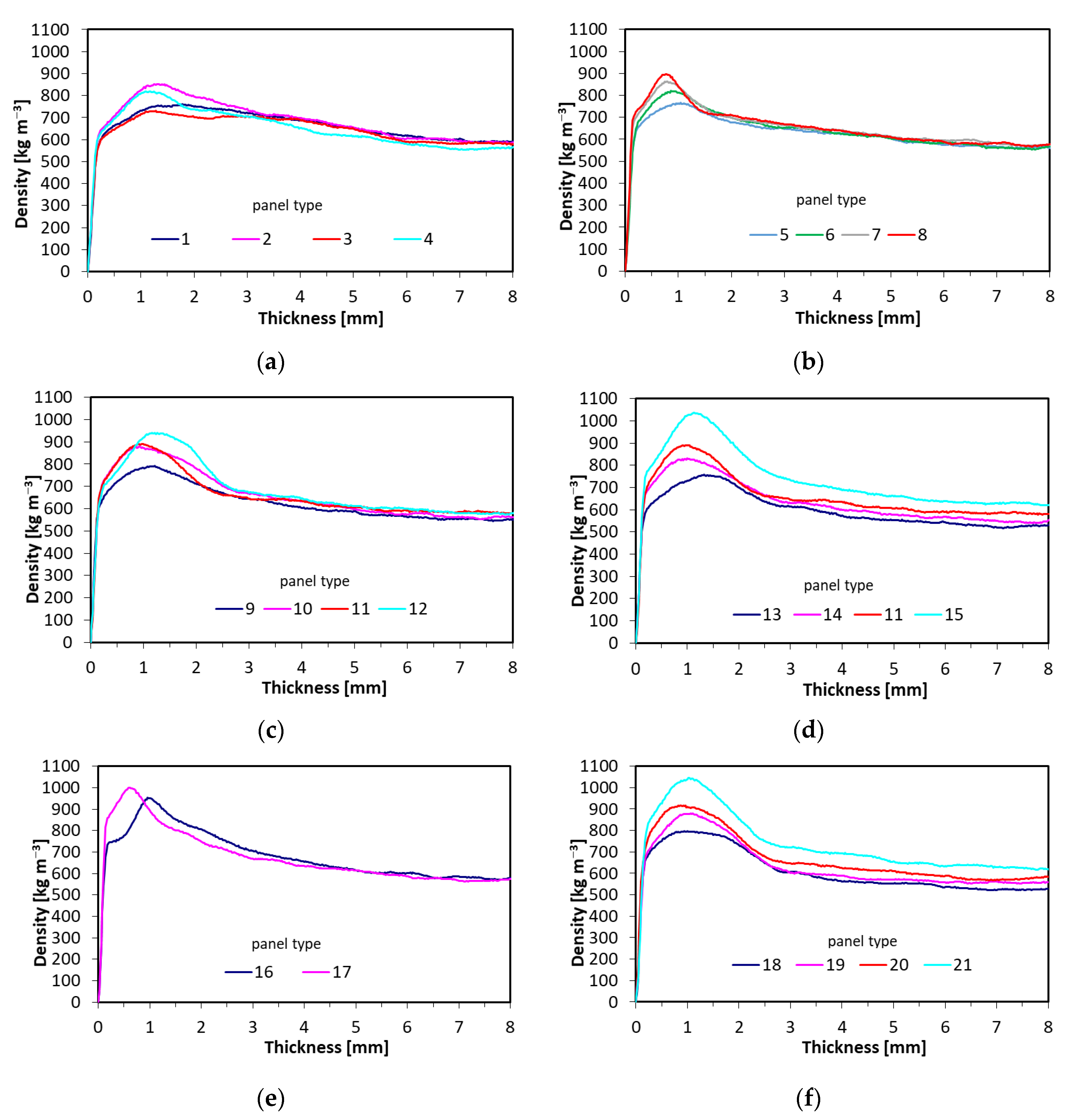
| Panel Type | Number of Layers | Nominal Density [kg m−3] | Face Layers’ Share [%] | Fiber Type ** | Fibers’ Share in Face Layers [%] |
|---|---|---|---|---|---|
| 1 | 1 | 660 | - | 1 | 0 |
| 2 | 25 | ||||
| 3 | 50 | ||||
| 4 | 75 | ||||
| 5 | 3 | 16 | 0 | ||
| 6 | 25 | ||||
| 7 | 50 | ||||
| 8 | 75 | ||||
| 9 | 32 | 0 | |||
| 10 | 25 | ||||
| 11 | 50 | ||||
| 12 | 75 | ||||
| 13 | 580 | 50 | |||
| 14 | 620 | 50 | |||
| 15 | 710 | 50 | |||
| 16 * | 5 | 660 | 25 | ||
| 17 * | 2 | 25 | |||
| 18 | 3 | 580 | 50 | ||
| 19 | 620 | 50 | |||
| 20 | 660 | 50 | |||
| 21 | 710 | 50 |
| Panel Type | MOR | MOE | IB | SS | Density ** | Rpm | Rvm |
|---|---|---|---|---|---|---|---|
| [N mm−2] | [kg m−3] | [µm] | |||||
| 1 | 11.4 (0.86) * | 1943 (136.5) | 0.46 (0.10) | 1.17 (0.16) | 592 (7) | 102.0 | 197.0 |
| 2 | 14.5 (3.00) | 2173 (231.3) | 0.55 (0.05) | 1.24 (0.20) | 586 (5) | 195.0 | 104.0 |
| 3 | 5.3 (0.83) | 967 (153.7) | 0.13 (0.02) | 0.41 (0.11) | 579 (5) | 49.0 | 58.7 |
| 4 | 10.7 (0.90) | 1503 (314.6) | 0.13 (0.03) | 0.44 (0.07) | 566 (5) | 42.1 | 36.3 |
| 5 | 10.6 (0.94) | 1901 (127.1) | 0.44 (0.03) | 1.06 (0.11) | 560 (4) | 54.4 | 127.6 |
| 6 | 12.5 (0.99) | 2166 (122.4) | 0.49 (0.05) | 0.77 (0.29) | 568 (4) | 44.8 | 102.6 |
| 7 | 14.4 (1.29) | 2363 (119.0) | 0.47 (0.03) | 1.19 (0.08) | 575 (6) | 29.3 | 47.5 |
| 8 | 15.6 (1.61) | 2320 (118.3) | 0.47 (0.04) | 1.23 (0.10) | 576 (6) | 47.5 | 83.6 |
| 9 | 11.8 (0.95) | 2017 (123.4) | 0.41 (0.03) | 1.17 (0.06) | 552 (5) | 83.6 | 134.5 |
| 10 | 15.9 (1.27) | 2359 (115.1) | 0.39 (0.02) | 1.46 (0.15) | 561 (5) | 60.4 | 110.5 |
| 11 | 17.1 (1.46) | 2435 (131.8) | 0.42 (0.04) | 1.47 (0.25) | 580 (5) | 42.3 | 46.6 |
| 12 | 16.2 (0.97) | 2290 (183.7) | 0.46 (0.04) | 1.04 (0.25) | 579 (4) | 39.1 | 46.9 |
| 13 | 11.1 (1.13) | 1550 (104.9) | 0.26 (0.03) | 0.91 (0.09) | 532 (4) | 30.2 | 38.6 |
| 14 | 13.7 (1.87) | 2071 (137.7) | 0.36 (0.02) | 1.05 (0.25) | 553 (6) | 44.6 | 49.6 |
| 15 | 17.1 (1.46) | 2435 (131.8) | 0.42 (0.04) | 1.57 (0.23) | 620 (8) | 28.6 | 37.8 |
| 16 | 16.6 (2.30) | 2418 (221.5) | 0.43 (0.05) | 0.70 (0.24) | 581 (6) | 22.6 | 23.7 |
| 17 | 16.7 (1.75) | 2457 (268.7) | 0.45 (0.05) | 1.18 (0.27) | 574 (6) | 18.0 | 18.1 |
| 18 | 10.9 (1.04) | 1611 (145.9) | 0.25 (0.05) | 0.83 (0.26) | 529 (3) | 34.7 | 46.6 |
| 19 | 12.8 (1.54) | 2074 (154.7) | 0.41 (0.05) | 1.32 (0.11) | 559 (6) | 56.4 | 112.4 |
| 20 | 15.4 (1.28) | 2337 (139.3) | 0.47 (0.03) | 1.34 (0.10) | 584 (6) | 30.0 | 31.6 |
| 21 | 19.5 (0.92) | 2966 (162.9) | 0.55 (0.04) | 1.25 (0.11) | 621 (8) | 24.6 | 34.7 |
Publisher’s Note: MDPI stays neutral with regard to jurisdictional claims in published maps and institutional affiliations. |
© 2022 by the authors. Licensee MDPI, Basel, Switzerland. This article is an open access article distributed under the terms and conditions of the Creative Commons Attribution (CC BY) license (https://creativecommons.org/licenses/by/4.0/).
Share and Cite
Wronka, A.; Beer, P.; Kowaluk, G. Selected Properties of Single and Multi-Layered Particleboards with the Structure Modified by Fibers Implication. Materials 2022, 15, 8530. https://doi.org/10.3390/ma15238530
Wronka A, Beer P, Kowaluk G. Selected Properties of Single and Multi-Layered Particleboards with the Structure Modified by Fibers Implication. Materials. 2022; 15(23):8530. https://doi.org/10.3390/ma15238530
Chicago/Turabian StyleWronka, Anita, Piotr Beer, and Grzegorz Kowaluk. 2022. "Selected Properties of Single and Multi-Layered Particleboards with the Structure Modified by Fibers Implication" Materials 15, no. 23: 8530. https://doi.org/10.3390/ma15238530
APA StyleWronka, A., Beer, P., & Kowaluk, G. (2022). Selected Properties of Single and Multi-Layered Particleboards with the Structure Modified by Fibers Implication. Materials, 15(23), 8530. https://doi.org/10.3390/ma15238530







